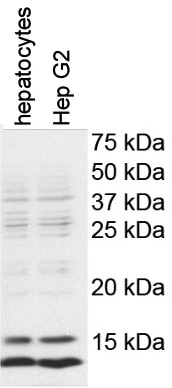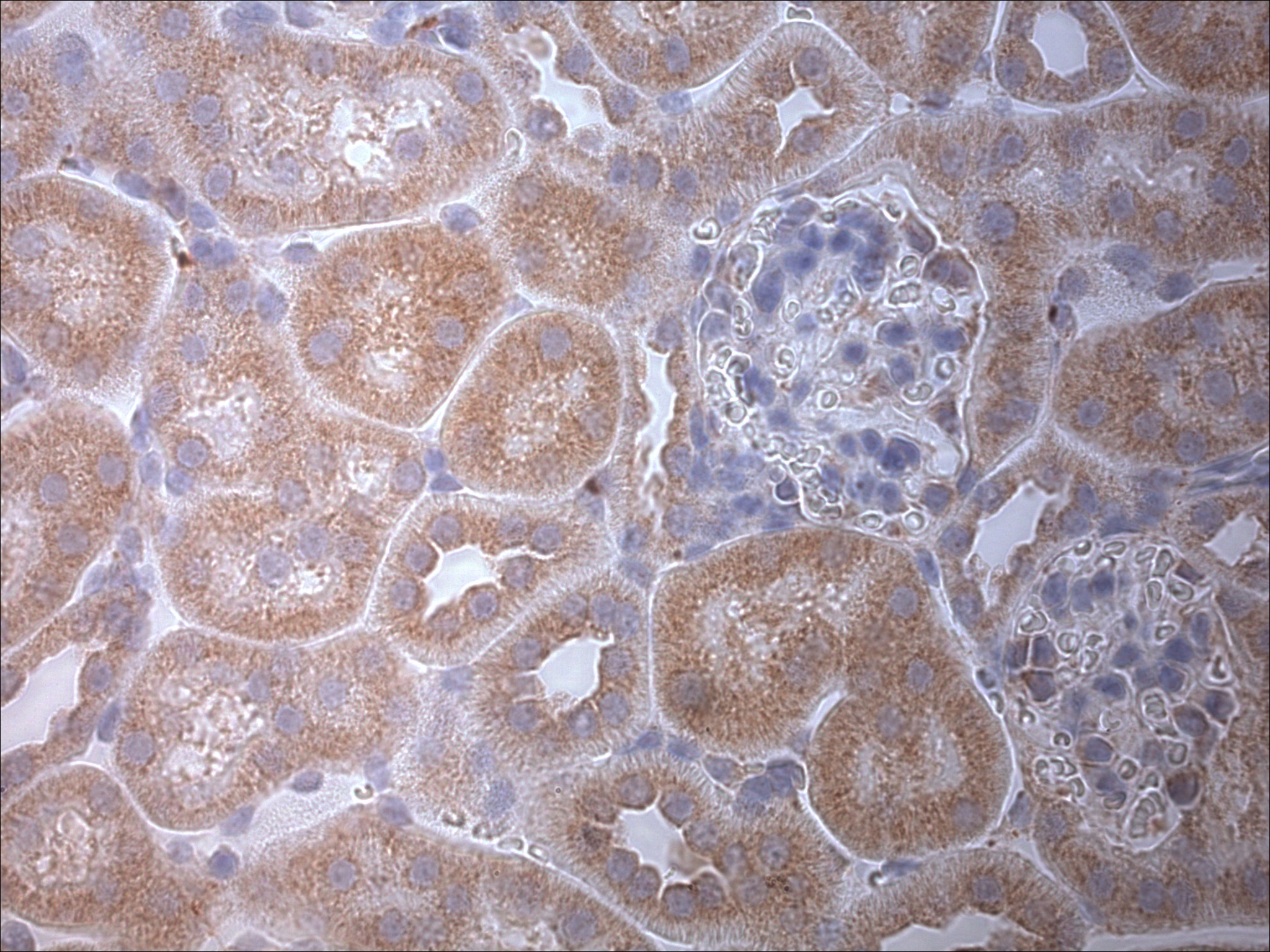| Reactivity | Hu, Mu, Rt, Am, Ca, Fi, Pl, Ze, BvSpecies Glossary |
| Applications | WB, Simple Western, ChIP, ELISA, Flow, ICC/IF, IHC, IP, NULL, WB, ChIP, IHC |
| Clonality | Polyclonal |
| Host | Rabbit |
| Conjugate | Unconjugated |
| Format | BSA Free |
| Concentration | 1.0 mg/ml |
| Immunogen | This LC3A Antibody was prepared from a synthetic peptide made to an internal portion of the human LC3 protein sequence (between residues 25-121). [Uniprot: Q9H492]. |
| Localization | LC3-I is cytoplasmic. LC3-II binds to the autophagic membranes. |
| Marker | Autophagosome Marker |
| Specificity | This LC3A Antibody detects both LC3A and LC3B. |
| Predicted Species | Bovine (100%). Backed by our 100% Guarantee. |
| Isotype | IgG |
| Clonality | Polyclonal |
| Host | Rabbit |
| Gene | MAP1LC3A |
| Purity | Immunogen affinity purified |
| Innovator's Reward | Test in a species/application not listed above to receive a full credit towards a future purchase. |
| Dilutions |
|
|
| Application Notes | Western blot bands are seen at ~19 kDa, representing LC3-I, and ~17 kDa, representing LC3-II. The observed molecular weight of the protein may vary from the listed predicted molecular weight due to post translational modifications, post translation cleavages, relative charges, and other experimental factors. Use in Southern blot reported in scientific literature (PMID: 21262964). In ICC, cytoplasmic staining was observed in HeLa cells. In Simple Western only 10 - 15 uL of the recommended dilution is used per data point. |
|
| Control | ||
| Reviewed Applications |
|
|
| Publications |
|
| Storage | Aliquot and store at -20C or -80C. Avoid freeze-thaw cycles. |
| Buffer | PBS |
| Preservative | 0.02% Sodium Azide |
| Concentration | 1.0 mg/ml |
| Purity | Immunogen affinity purified |
| Images | Ratings | Applications | Species | Date | Details | ||||||||||
|---|---|---|---|---|---|---|---|---|---|---|---|---|---|---|---|
|
reviewed by:
Verified Customer |
ICC | Human | 05/21/2021 |
Summary
|
|||||||||||
|
reviewed by:
Verified Customer |
WB | Rat | 05/21/2021 |
Summary
|
|||||||||||

Enlarge |
reviewed by:
Verified Customer |
WB | Human | 06/09/2020 |
Summary
Comments
|
||||||||||

Enlarge |
reviewed by:
Verified Customer |
WB | Mouse | 01/29/2019 |
Summary
|
||||||||||

Enlarge |
reviewed by:
Verified Customer |
WB | Human and Mouse | 11/25/2017 |
Summary
|
||||||||||

Enlarge |
reviewed by:
Verified Customer |
WB | Mouse | 08/07/2017 |
Summary
|
||||||||||
|
reviewed by:
jennifer guadagno |
WB | Mouse | 10/06/2015 |
Summary
|
|||||||||||

Enlarge |
reviewed by:
Verified Customer |
WB | Human | 01/12/2015 |
Summary
|
||||||||||
|
reviewed by:
Verified Customer |
WB | Mouse | 12/12/2014 |
Summary
|
|||||||||||

Enlarge |
reviewed by:
Verified Customer |
IF | Mouse | 11/25/2014 |
Summary
|
||||||||||
-(01-ml)_NB100-2331_10836.jpg)
Enlarge |
reviewed by:
Merissa Olmer |
IHC-P | 10/04/2014 |
Summary
|
|||||||||||
-(01-ml)_NB100-2331_8521.jpg)
Enlarge |
reviewed by:
Ilya Ulasov |
WB | Human | 06/30/2014 |
Summary
|
||||||||||
|
reviewed by:
Verified Customer |
WB | Human | 06/20/2014 |
Summary
|
|||||||||||
-(01-ml)_NB100-2331_6741.jpg)
Enlarge |
reviewed by:
Kumsal Tekirdag |
WB | Human | 04/02/2014 |
Summary
|
||||||||||

Enlarge |
reviewed by:
Nirmala Parajuli |
IHC | Mouse | 08/13/2012 |
Summary
|
||||||||||

Enlarge |
reviewed by:
Verified Customer |
WB | Human | 12/28/2011 |
Summary
|
||||||||||
|
reviewed by:
Verified Customer |
WB | Human | 11/21/2011 |
Summary
|
|||||||||||
|
reviewed by:
Verified Customer |
WB | Human | 11/21/2011 |
Summary
|
|||||||||||
|
reviewed by:
Verified Customer |
WB | Mouse | 10/24/2011 |
Summary
|
|||||||||||
|
reviewed by:
Seung-Hyun Ro |
WB | Mouse | 07/08/2010 |
Summary
|
|||||||||||
|
reviewed by:
Verified Customer |
WB | Other | 11/05/2009 |
Summary
|
|||||||||||
|
reviewed by:
Verified Customer |
WB | Human | 02/18/2009 |
Summary
|
Secondary Antibodies |
Isotype Controls |
Research Areas for LC3A Antibody (NB100-2331)Find related products by research area.
|
|
Read full blog post. |
|
Losing memory: Toxicity from mutant APP and amyloid beta explain the hippocampal neuronal damage in Alzheimer's disease By Jamshed Arslan Pharm.D. Alzheimer's disease (AD) is an irreversible brain disorder that destroys memory and thinking skills. The telltale signs of AD brains are extracellular deposits of amy... Read full blog post. |
|
Nuclear LC3: Why is it there and what is it doing? By Christina Towers, PhD. Cells use the complex process of autophagy to degrade and recycle cytoplasmic material. There are over 20 proteins that have been implicated in this process and appropriately named core ... Read full blog post. |
|
Why LC3B Antibodies Make Ideal Autophagosomes Membrane Markers The human form of microtubule-associated protein light chain 3 (LC3) is expressed as 3 splice variants LC3A, LC3B, and LC3C.1 LC3B is a subunit of the MAP1A and MAP1B microtubule-binding proteins and plays a central role in autophagosome membrane stru... Read full blog post. |
The concentration calculator allows you to quickly calculate the volume, mass or concentration of your vial. Simply enter your mass, volume, or concentration values for your reagent and the calculator will determine the rest.
5 | |
4 | |
3 | |
2 | |
1 |
| Verified Customer 05/21/2021 |
||
| Application: | ICC | |
| Species: | Human |
| Verified Customer 05/21/2021 |
||
| Application: | WB | |
| Species: | Rat |
| Verified Customer 06/09/2020 |
||
| Application: | WB | |
| Species: | Human |
| Gene Symbol | MAP1LC3A |